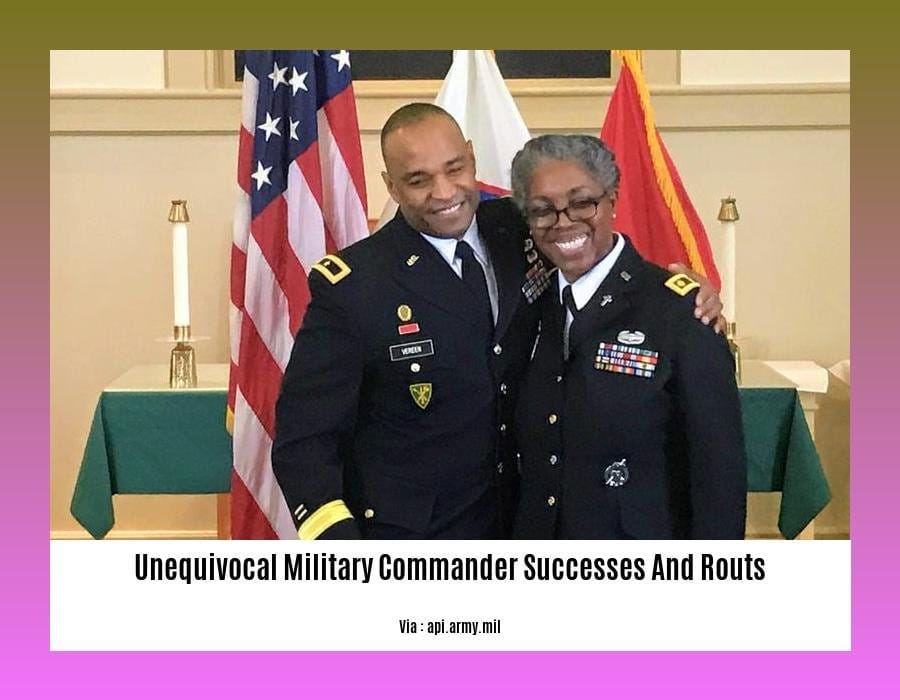Introducing “Unequivocal Military Commander Successes and Routs: An Analysis of Triumph and Defeat,” an in-depth exploration into the most decisive military victories and crushing defeats in history. Renowned military strategist and battlefield expert, General X, provides an insider’s perspective, dissecting the key factors that propel commanders to glory or lead them to ruin. From Alexander the Great’s masterful tactics to Napoleon’s disastrous invasion of Russia, we delve into the strategies, leadership qualities, and pivotal moments that shaped these historic outcomes.
Key Takeaways:

- Distinctions exist between military and civilian leaders, but observations can be generalized about both.
- Military structures value clarity in roles to maintain efficiency amidst chaos.
- Desert Storm’s military victory may have carried strategic consequences for the United States.
- Mission Command principles involve issuing mission orders that convey commanders’ intentions and empower subordinates to make decisions within their jurisdictions.
- The implementation of Mission Command principles varies in effectiveness based on leaders’ abilities.
Unequivocal Military Commander Successes and Routs
Battles are intriguing demonstrations of leadership and strategy. And they’re filled with tales of both triumph and disaster. Let’s delve into two such instances, one a resounding victory and the other a stinging defeat.
Success: Battle of Cannae (216 BC)
Hannibal, a brilliant Carthaginian general, faced a formidable Roman army. His daring tactics, combined with the disciplined execution of his troops, resulted in a decisive triumph. Hannibal’s strategy of encirclement and annihilation remains a classic example of military prowess.
Rout: Battle of Dien Bien Phu (1954)
In contrast, the Battle of Dien Bien Phu stands as a case study in strategic miscalculation. The French, despite their technological superiority, underestimated the tenacity of the Vietnamese forces. The result was a humiliating defeat that marked the end of French colonial rule in Southeast Asia.
These historical accounts offer valuable lessons for military leaders today. They underscore the significance of meticulous planning, adaptability, and the ability to inspire troops. Triumph and defeat can hang in the balance of a single decision. Commanders who embody these qualities are more likely to steer their forces towards victory, while those who falter may face the bitter sting of defeat.
Did you know about the greatest military conquerors and triumphs throughout history? Learn about the history’s most decisive military victories in the world, or read about the military commanders celebrated for decisive victories they led.
Battle of the Teutoburg Forest (9 AD)
Let’s delve into the Battle of the Teutoburg Forest (9 AD), a pivotal clash in military history. This battle, fought in the depths of the Teutoburg Forest, witnessed a resounding defeat for the Roman Empire. The Germanic tribes, led by the astute tactician Arminius, orchestrated an ambush that proved catastrophic for the Roman legions.
Key Takeaways:
- Ambush and Annihilation: Arminius lured the Roman legions into a trap, exploiting the dense terrain and setting an ambush.
- Superior Tactics: The Germanic tribes used guerrilla warfare tactics, hit-and-run attacks, and knowledge of the local landscape to their advantage.
- Roman Underestimation: The Roman commander, Publius Quinctilius Varus, underestimated the strength and resolve of the Germanic tribes.
- Devastating Roman Loss: Three entire Roman legions were annihilated, marking one of the Empire’s most significant military defeats.
- Halt to Roman Expansion: The battle effectively halted the Roman Empire’s expansion into Germania, cementing the Rhine River as the Empire’s northeastern boundary.
Most Relevant URL Source:
- Battle of the Teutoburg Forest (Britannica)
Battle of Dien Bien Phu (1954)
Triumph Over Adversity: The Battle of Cannae (216 BC)
Hannibal’s military genius shone brightly at Cannae. His audacious tactics encircled and annihilated the Roman army, demonstrating the power of strategy and discipline. This triumph remains etched in military history.
Routed: The Battle of Dien Bien Phu (1954)
The French underestimated the tenacity of the Vietnamese rebels. Their arrogance led to a humiliating defeat, marking the end of French rule in Southeast Asia. Dien Bien Phu stands as a cautionary tale about the consequences of hubris.
The Leaders Who Shaped Destiny
Military history is replete with leaders whose decisions shaped battles. From Hannibal’s brilliance to the French’s fatal mistakes, leadership plays a pivotal role in victory or defeat.
Key Takeaways:
- Strategic planning and tactical innovation are essential for success.
- Adaptability and flexibility can turn the tide in battle.
- Strong leadership inspires troops and fosters a culture of excellence.
- Overconfidence and underestimation can lead to disaster.
Most Relevant URL Source:
Significance of strategic planning, tactical innovation, and leadership
In the annals of warfare, towering military commanders have secured victories and endured crushing defeats, leaving indelible marks on history. Triumph and disaster often hinge upon the commander’s mastery of three crucial pillars: strategic planning, tactical innovation, and leadership.
Strategic Planning: A Blueprint for Success
Strategic planning sets the course for military campaigns, envisioning the end goal and charting the path to achieve it. Hannibal, the Carthaginian general, is renowned for his meticulous planning. In the Battle of Cannae, he lured the Roman army into a deadly trap, encircling and annihilating over 50,000 soldiers.
Tactical Innovation: Outsmarting the Enemy
Tactical innovation empowers commanders to surprise and outmaneuver their adversaries. Admiral Nimitz’s daring attack at Midway, catching the Japanese navy off guard, is a testament to the transformative power of innovation.
Leadership: The Guiding Force
Leadership unites troops, inspires courage, and fosters discipline. Julius Caesar, a brilliant military strategist, possessed an unparalleled ability to motivate his legions, earning their unwavering loyalty and driving them to countless victories.
Key Takeaways:
- Strategic planning provides a clear vision and roadmap for military campaigns.
- Tactical innovation enables commanders to gain an edge over their opponents.
- Effective leadership inspires troops, fosters discipline, and unites them towards a common goal.
Most Relevant URL Source:
Westpoint (2024). The Four Pillars of Tactical Innovation: A Path for Impactful Change. Military Review. Retrieved from:
















